Family : Helodermatidae

Text © Prof. Giorgio Venturini

English translation by Mario Beltramini
Heloderma suspectum, Cope, 1869, the so-called Gila monster or simply Gila, is a big lizard of the family Helodermatidae, belonging to the order of the Squamata.
Due to its size (together with Heloderma horridum it is the biggest lizard of northern America), the unmistakable look and the venomousness of its bite it is one of the lizards most known to the public and to the frequenters of the zoological gardens, of which it is often a guest.
The name Heloderma refers to the warty look of its skin and comes from the Greek helos (ἧλος) “nail or wart” and derma (δέρμα) “skin”; suspectum (in Latin “suspicious”) refers to the venomousness that, at the times of E.D.Cope, who described the species in 1869, was not yet scientifically proved. The vulgar name of Gila monster comes from the river Gila, tributary of the Colorado River, that flows in a region once rich of these lizards.
The family of the Helodermatidae counts the only genus Heloderma, with two species traditionally recognized: Heloderma suspectum (with two subspecies Heloderma suspectum cinctum Bogert & Martín del Campo,1956 and Heloderma suspectum suspectum Cope, 1869) and Heloderma horridum (with four subspecies). After a more modern revision, based especially on the analysis of the nucleotidic sequences of the DNA, the subspecies of Heloderma horridum have been by some authors raised to the rank of species.
This family has a very ancient origin, in fact its fossil members, such as Estesia and Paraderma date back to almost 70 million of years ago, that is to the Cretaceous, whilst the genus Heloderma had already appeared in the Miocene, more than 20 million of years ago, with Heloderma texana.
The morphology of the teeth and of the skull of the fossil helodermatids suggest that already in the Cretaceous these lizards were endowed of a venomous bite similar to the one of the modern Gila. Even if Heloderma suspectum and Heloderma horridum (with their subspecies or related species) have morphology and ecology quite similar, phylogenetic analyses have shown that the evolutionary divergence between these species date back to very remote times, estimated in approximate 30 million of years.
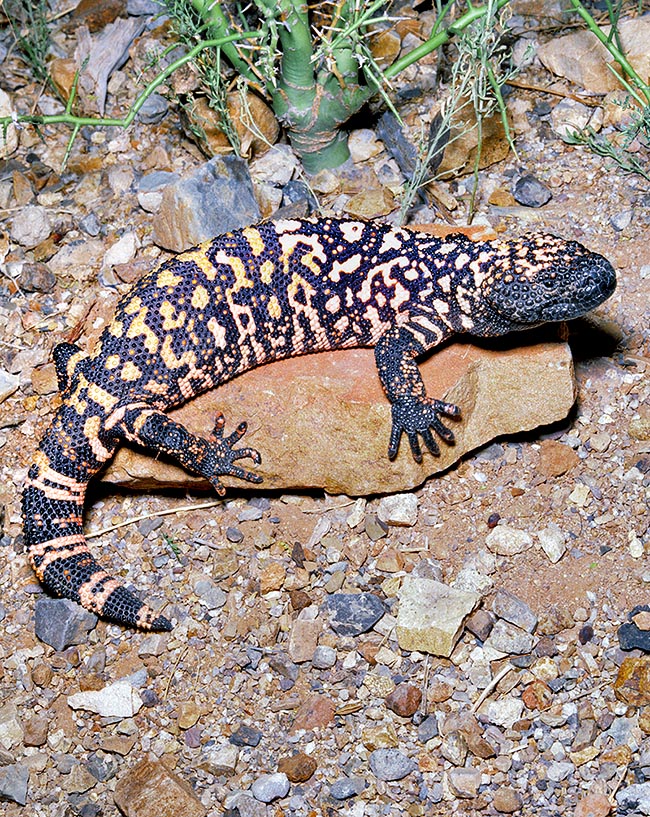
The Heloderma suspectum owes its scientific name to the fact that in 1869 was suspected venomous. The stocky body may exceed 50 cm with unmistakable colours and mimetic scales that remind the dangerousness of the bite © Giuseppe Mazza
Heloderma suspectum has the appearance of a big and stocky lizard, that may exceed the length of 50 cm, equipped with a large and flat head and of powerful mandibles, short legs with fingers armed with robust claws, and of a big tail. The skin is covered by scales, and, on the side, displays evident protuberances, due to the presence in the derma of bony formations, the osteoderms, that recall the bony scales of the tegument of the crocodiles, and that justify the denomination of the genus. The osteoderms in the cephalic zone are fused with the cranial bones.
The colouration of the skin is a curious mosaic of black, pink, yellow, orange and cream, that grants a certain camouflage in the irregular vegetation of the semi-desert environments representing the habitat of this species. It is also possible that the characteristic livery is an aposematic warning that signals to the potential predators the venomousness of this lizard (aposematic are defined those colourations, often showy, typical of dangerous or poisonous animals or not edible because disgusting, that have the function of discouraging an eventual aggressor. A typical example is the livery of the wasps or of the bees).
Specimens in captivity, regularly fed, can reach a weight of about 1200 g, whilst the newborns weigh 30-40 g. The wild animals have usually a minor weight because, with a less regular feeding, have a minor possibility of storing reserve fat.
The tail represents the main location of accumulation of fats and after a meal, for some days, its diameter is clearly greater than the norm. In this species the autotomy of the tail is not observed, whereas commonly happening in the lizards. If, following a trauma the tail is amputated, it is not in condition of being regenerated.
The mouth is big and the bite powerful thanks to the strong musculature, and is capable to crush the head of small rodents. The tongue, of dark colour and biforked, is very flexible and everted and is utilized to help the moving of the food towards the throat, to drink, to lick the contents of the crushed eggs and to clean the external part of the mouth. Furthermore, the tongue plays an essential role in the sense of smell, as starting from the moment it is everted it seizes with the saliva that moistens it the odorous molecules, to then carry them to the olfactory Jacobson’s organ, placed on the vault of the palate.
The ear is protected externally by a membrane. The eyes have round pupil and two mobile eyelids, besides a transparent third one, the nictitating membrane, that has the role of protecting and humidifying the cornea. The appearing of big mobile objects in the field of view causes the emission of a hissing verse. On both sides of the lower jaw are present the venom glands, modified salivary glands formed by 3 or 4 lobes. From each lobe departs a duct carrying the venom towards the gums and to the furrows present on the fore surface of the teeth. The venom has a characteristic smell, well noticeable when the animal gets ready for biting. The glands are well visible outside, under form of evident swellings under the lower lip.
The up to 5 mm long teeth, are sharp and display a longitudinal groove along which flows the venom, the base is flattened and wrinkly and each tooth is strictly anchored to the bones of the jaws by a fibrous connective tissue (pleurodont teeth). The teeth are periodically replaced with a cycle in successive waves: are replaced at the same time the first, the fourth and the seventh tooth, then the second, fifth and eighth and so on. If a tooth accidentally breaks for being replaced it will have to wait for its cyclic turn. The renewal of the teeth lasts all the life. The lungs are strongly expandable, this property, besides allowing a reduced frequency of the respiratory acts, is exploited by the animal to inflate the chest with the purpose of increasing the body size to intimidate possible opponents.
Heloderma suspectum is present in the south-western zone of USA, and in particular in Arizona, New Mexico, Utah, California, Nevada, and in Mexico (Sinaloa and Sonora). Its characteristic habitat is that of the shrubberies, semi desert areas with vegetation of succulents and arid forests: in these environments it has its dens dug, in the soil or under the rocks, where anyway is ready the access to the water.
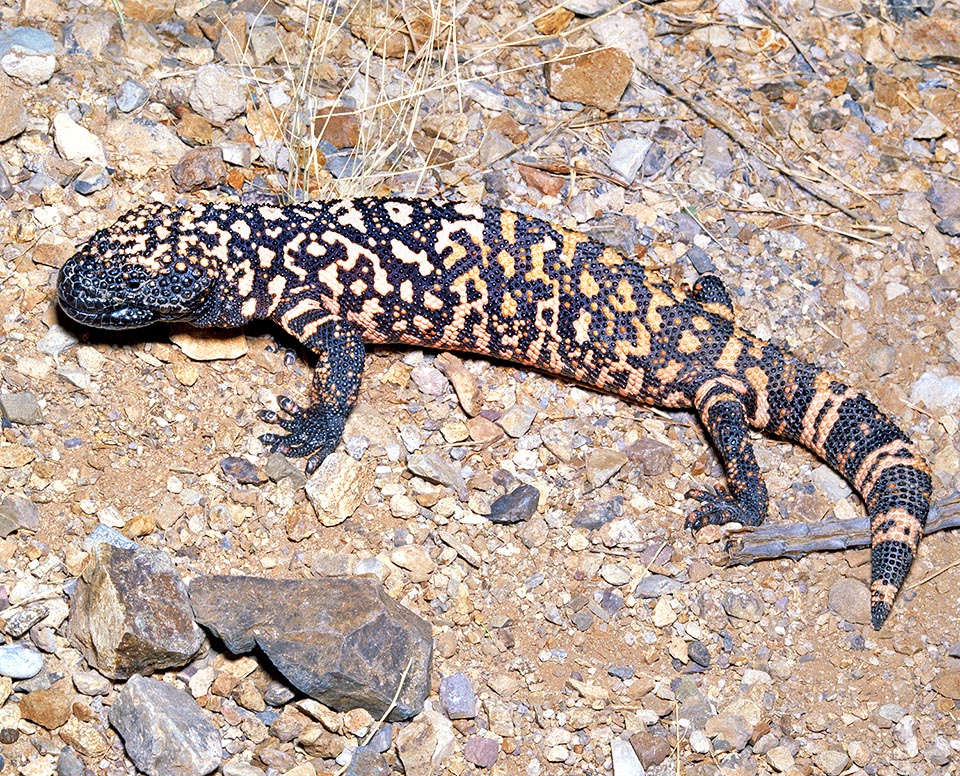
It lives in the south-western zone of USA (Arizona, New Mexico, Utah, Nevada, California) and in Mexico (Sinaloa and Sonora) often in semi-desert sites where it stands even the 44 °C. It protects itself from dehydration spending almost 90% of its time in dens or in shady shelters. The skin is practically waterproof to reduce the water losses © Giuseppe Mazza
Given the dryness of the habitats it frequents, for protecting from the dehydration this animal spend almost 90% of the time in its shady shelters and periodically moves to a different shelter looking for an optimal microclimate. Furthermore, the skin is practically waterproof and the loss of water takes place only through the cloaca.
During the warmest periods, the Heloderma suspectum rarely leaves its shelter, and dedicates to hunting only when the habitat temperature allows to maintain the body temperature between the 25-30 °C, even if the pregnant females prefer slightly superior temperatures. Seen the thermal demands these animals are active especially in the less warm hours of the morning or in the warm nights. Some individuals have remained in a dormancy status in their underground shelters for several years in occasion of a period of exceptional drought. Between a meal and the other can pass many days or even some months, for this entrusts on the large deposits of body fat that are placed especially in the tail and around the kidneys. These animals survive to short exposition to very low temperatures, up to 3-4 °C below zero and to a maximum of 44 °C.
The Gilas are active all the year round, even if with differences in the various seasons. In spring and in autumn the activity occurs especially late in the morning and in late afternoon, whilst in summer the animals are more active during the coolest hours of the early morning or of the evening and, at times, even of night. In the coldest months the activity is very limited and concentrated in the warmest hours. Even if the time spent out seems usually dedicated mainly to hunting or looking for a partner for the mating, in the most humid periods the animals are very active and move around without apparently looking for preys or for a partner. After a tradition of some native populations a particularly intense activity of these animals announces a long and cold winter.
Feeding
The Heloderma suspectum may nourish of a remarkable variety of prey, such as small mammals, birds, reptilians and some invertebrates, worms and insects, but preferably it attacks the nests of birds or of other reptilians, where it devours the young and especially the eggs. The robust legs, especially the fore ones, and equipped with strong and sharp claws, allow the animal to easily dig into the soil looking for preys and to climb the trees to reach the nests of birds. The smallest eggs are taken in the mouth and broken with the fore teeth, then moved more inside the mouth where they will be completely crushed. Conversely, in case of bigger eggs, after having broken the shell with the fore teeth, the animal licks the content with the tongue.
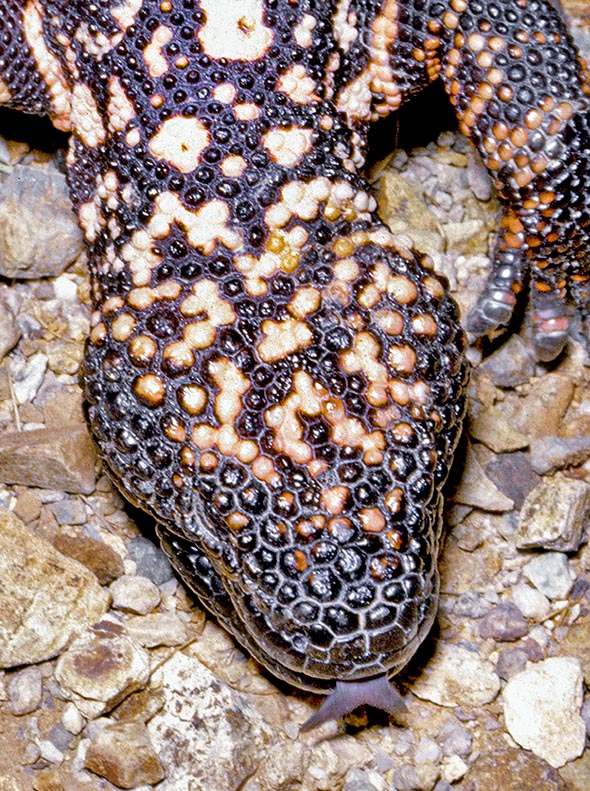
The head, big and flat, has powerful jaws that do not leave the grip while the venom flows between the teeth. Unlike snakes, it comes from showy glands placed at the base of the lower jaw. The biforked dark tongue, very flexible, serves for nourishing, cleaning the lips and for drinking. Furthermore, it carries with the saliva the odorous molecules of the olfactory Jacobson’s organ, placed on the vault of the palate © Giuseppe Mazza
The Gila monster can swallow also preys of remarkable size, if compared to its own size, and it has been observed a specimen gulping a little young of rabbit whose weight was about one third of that of the predator.
The home range of this species may exceed in some cases the 50 hectares and it is not difficult that some specimens move for more than 1,5 km in one day.
For the research of the preys the Heloderma suspectum entrusts mainly on the smell and hearing. The animal is very sensitive to the vibrations of the soil that advise it about the presence of nests with newborns even if hidden underground or among the vegetation. These reptilians are capable to ingest in one only meal a quantity of food equal to the 50% of their body weight.
Three or four abundant meals consumed during a spring furnish it energy reserves sufficient for the whole year.
The venom of the Gila monster
The venomousness of the members of the genus Heloderma is now recognized and well described, even if till a quite recent past it has been object of discussion. The same Edward Drinker Cope, the scholar who described the species in 1869, was unsure if to consider it venomous to the point to baptize it “suspectum”: suspect of venomousness.
During the following years the experiments done on the saliva and on the bite of the Gila gave conflicting results and only in 1883 the venomousness was definitely demonstrated.
It is possible that the conflicting results of the experiments on the toxicity of the saliva were due to the fact that, in the salivary gland, the parts producing the venom are distinct from those producing the normal saliva and that therefore the experimenters in some cases extracted the venom and in others just some harmless saliva. The real dangerousness of the bite for the man has been often exaggerated. In the stories of the pioneers of the West they talk of Gila Monsters of extraordinary size, weighing up to 15 kg; whose bite was rapidly fatal for the man and whose breath was even very venomous.
Actually, the saliva of Heloderma contains several toxins and, as toxicity, may be compared to that of the rattlesnakes, but the quantity relatively modest that is inoculated and the characteristics of the teeth and of the mechanism of inoculation of the venom, make that the bite is not really lethal for the man, if not in exceptional instances. We have also to remind that the Gila is an animal with slow movements and not aggressive: in most of the cases the bites concern persons that were handling carelessly some specimens kept in captivity. The most serious cases concern bites inflicted not to the fingers, as in the most common cases, but to the abdomen or to the neck: we remember in particular the case of a young woman who had hidden a Gila under her dresses, maybe as a joke, and had been bitten in the abdomen. The rescuers in order to be able to loosen the bite had to cut the head of the animal and the woman, hospitalized for strong pains, vomiting and profuse diarrhea, in a state of hypotensive shock, remained under intensive care for three days.
There is no recent sure confirmed news about human demises occurred after a bite of the Gila, and the cases reported in the past are probably to be imputed to clumsy attempts of therapeutic interventions or to misinformation. A review of the journalistic news about the outcome of bites of Heloderma even concludes that, between 1880 and 1956, on 136 cases, 36 had a fatal outcome. More recent reviews, that have analyzed news coming from verifiable sources, do not report mortal outcomes and suggest that, instead, the bite is not mortal for the man if not exceptionally.
The bite actually results extremely painful, perhaps more than that of any snake, with edema of the affected part, and arise weakness, fever and rapid decrease of the blood pressure, that in the most serious cases may lead to a shock. Tachycardia may appear, and in some case have occurred myocardial infarcts. Some persons have also displayed difficulty in breathing. The bleeding of the wound may be remarkable; not due to the venom but due to the lacerations caused by the teeth.
Seen the great heterogeneity of the toxic substances present in the saliva, it does not appear possible to produce a suitable anti-poison serum. The treatment of the bite of these animals is consequently only the symptomatic one of support.
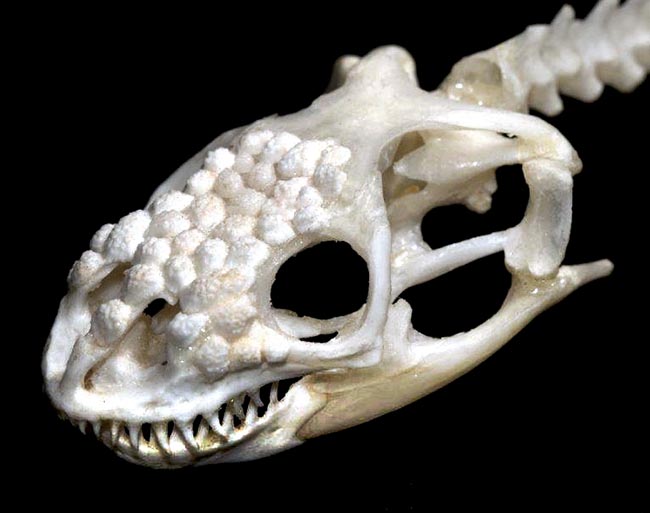
The skeleton of the head shows the osteoderms forming the stony bones, here fused to the cranial bones. The sharp, 5 mm long teeth, renew all life, independently from the use, following a well precise scheme © Dr. med. vet. Laube
Contrary to what happens in the venomous snakes, whose venom is produced by salivary glands located in the upper jaw, the venomous glands of the Gila monster are placed in the lower jaw and the venom ducts carry the secretion towards the gums from where, by capillarity, reaches the teeth. The venomous glands are visible from outside as a big swelling under the back part of the lower lip. Being absent a musculature able to inject forcefully the venom, in occasion of the bite, the chewing movements compress the gums and the venom can flow along the teeth thanks to the grooves present on their surface. Seen that the Gila after having beaten hardly leaves the grip, the venom has a better possibility to flow inside the wound. If no intervention occurs, the Gila keeps the jaws tightened for a long time and at times does not release the affected part for some hours.
The members of the genus Heloderma appear to be resistant to their own venom or to that of other individuals of the same species. Their venom contains a complex mix of substances, some of which similar to those present in the venom of many snakes, among which the hyaluronidase, the phospholipase A2, and the serotonin. The enzyme hyaluronidase catalyzes the demolition of the hyaluronic acid, molecule that determines the viscosity of our connective tissues: in this way increases their permeability and facilitates the diffusion of the venom in our organism, besides contributing to the production of edemas. The phospholipase A2 has various effects, causing damages to the cellular membranes, causing a blockage of the neuromuscular transmission and realizing pro-inflammatory molecules. The serotonin is a neurotransmitter that has effects on the smooth musculature causes vasodilation and acts as inflammatory mediator. The saliva, furthermore, contains various peptides and proteins among which we count:
– Nerve Growth Factor (NGF), molecule present also in the venom of many snakes that stimulates the growth of the nerves but that also contributes in an important manner to the inflammatory action.
– Helodermin, that causes lethargy, paralysis of the smooth musculature and hypothermia. It can be fatal if injected in the animals.
– Toxins kallikrein-like: Gilatoxin, Horridum toxin (present in the venom of Heloderma horridum, uncertain the presence in Heloderma suspectum), Helodermin and also a lethal toxin still now without name. These substances are the main responsible of the strong pain felt after the bite, cause edema, hypotension, internal bleedings, in some cases muscular paralysis and neurotoxicity. They are potentially lethal toxins.
Besides these toxic substances, have been found in the saliva other molecules and in particular the exendin, that have attracted a very big interest for their physiological functions and for the pharmacological applications. The Heloderma suspectum, who eats usually 3 or 4 times per year, is able to bear very long periods of fasting. The physiological bases of this remarkable capacity are probably to be found in the presence in the saliva of substances called exendins, that slow down the digestion and the absorption of the food. The term exendin refers to the fact that they are molecules produced by an exocrine gland like the salivary (from exocrinous), that regulate the endocrine functions like those of the pancreas. Of particular interest is the exendin-4: this peptide has a remarkable resemblance to the human GLP-1 (glucagon-like peptide-1), a hormone that increases the production of insulin when the levels of hematic glucose are high. The exendin-4 is stronger than the human GLP-1 in its effects on the production of insulin, reduces the production of glucagon (hormone that, at least for some aspects, has a function contrary to the one of the insulin), slows down the gastric emptying and moreover its action is of much bigger duration than that of the human hormone, being resistant to the enzymatic degradation.
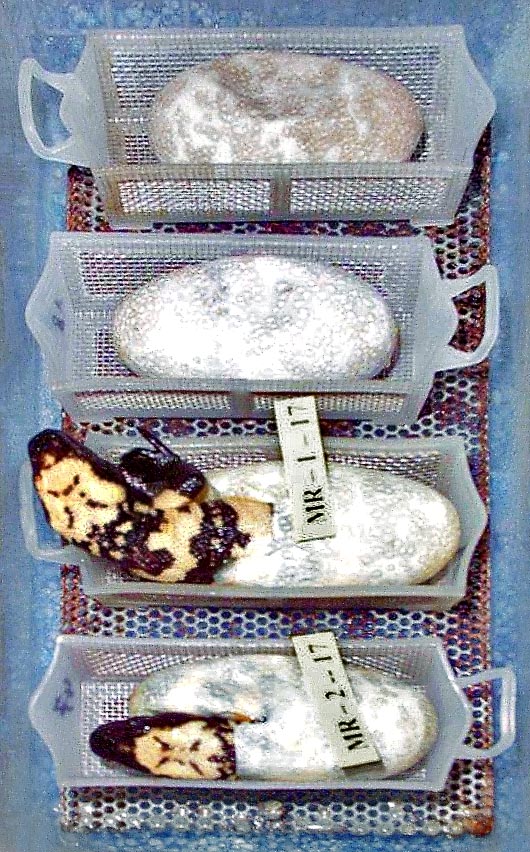
Eggs hatching of Heloderma suspectum in incubator. The venom of the Gila Monster is now object of promising medical studies for various pathologies © J. Schwandt – Heloderma.net
Starting from 2005, it has been introduced in the therapy of the diabetis of II type a synthetic form of the exendin-4, with the name of Exanatide or Byetta, that is effective in those patients that do not respond to the traditional oral treatments.
One of the exendins, the exendin-2 or helodermin, is attracting a lot of attention as, according to recent studies, results being able to inhibit, at least in vitro, the proliferation of the cells of some lung tumors.
Another molecule of remarkable interest extracted from the saliva of the Gila Monster, is the Gilatide, a peptide derived of the exendin-4, that, after experiments done on the mouse, is in condition to improve in a quite remarkable way the capacities of learning and the memory. Presently are under study the possible utilizations of this molecule in the treatment of patients affected by memory disorders, such as, for instance, those associated to the Alzheimer’s disease.
Regardless of therapeutic use of this molecule it is interesting to wander what can be the functional meaning of the presence of a substance that stimulates the memory in the venom of a Heloderma. We might think that the association of a toxin that produces an excruciating pain with a substance that increases the memory of this experience could be a very effective formula in the defense against the aggressors.
A topic under discussion is that concerning the adaptive meaning of the venom of Heloderma: like for all animal venoms the primary function can be defensive against an attacker or offensive, aimed at killing or paralyzing a prey and possibly pre-digesting it. In the case of venomous snakes, the venomous bite carries mainly these offensive functions, allowing the animal to hunt fast preys, dangerous and often of great size. In the case of the Gila, that mainly nourishes of eggs or of nestlings and occasionally of small vertebrates, of size always smaller than that of the predator and that do not require to be paralyzed or killed rapidly, it seems probable that the primary function of the venom must be the defensive one. The function of pre-digestion seems to be excluded seen that none of the toxins of the Gila is able to digest appreciably a prey before the ingestion.
The effects of the bite of the Heloderma, that is the rapid appearance of an excruciating pain in the affected point, that rapidly extends to other parts of the body, edema (swelling), nausea, vomit and hypotension seem instead to favor the hypothesis of the defensive and also deterrent role.This hypothesis is also sustained by the observation that the bites are often preceded by menacing behaviors, consisting in the wide opening of the mouth and in the emission of hissing sounds.
The Heloderma suspectum spends most of its time hidden in shelters that protect it from the predators, but when it moves looking for preys or for a partner for the mating, due to its slowness and the livery poorly camouflaging it becomes an easy target of the predators, in particular raptors and coyotes to which hardly can escape. In these conditions the venomousness of its bite becomes an essential instrument for the survival, because the predators who attack it will suffer for the rapid effects of the poisoned bite and will interrupt the attack, as well as because the predators that in the past have experienced these effects probably will avoid it.
We can ask ourselves why, among so many saurians, only the Heloderma have evolved a defensive mechanism based on the venom. In the first place we have to recall that, contrary to the Gilas, most of the lizards are able to escape the aggressors with a very fast run, but we have also to underline that the production of venomous saliva in this type of animals is much more diffused than what is generally believed. The best known case is that of the Komodo dragon (Varanus komodoensis) whose bite is really venomous (and not only dangerous as source of infections, as once was thought), but also other monitor lizards and some iguanas can produce venomous saliva.
Reproduction
The duration of the life of these animals when in liberty is not known, whilst in captivity they usually live up to 20 or more years, with a maximum reported duration of 36 years.
The Heloderma suspectum have 36 chromosomes, the female has sexual chromosomes ZW, whilst the male ha sexual chromosomes ZZ. Their coupling in the wild has never been observed, as a consequence all the descriptions refer to captive specimens. The Gila become sexually active during the third-fourth year of life, when they reach a total body length of about 22-24 cm with reproduction usually in alternate years. The mating occurs in spring, when the food is more abundant, in this period happen fights between males, usually only ritual, for gaining the access to the female. At times the female accepts the copulation only after a courting that may last even two hours, during which it can also bite the male.
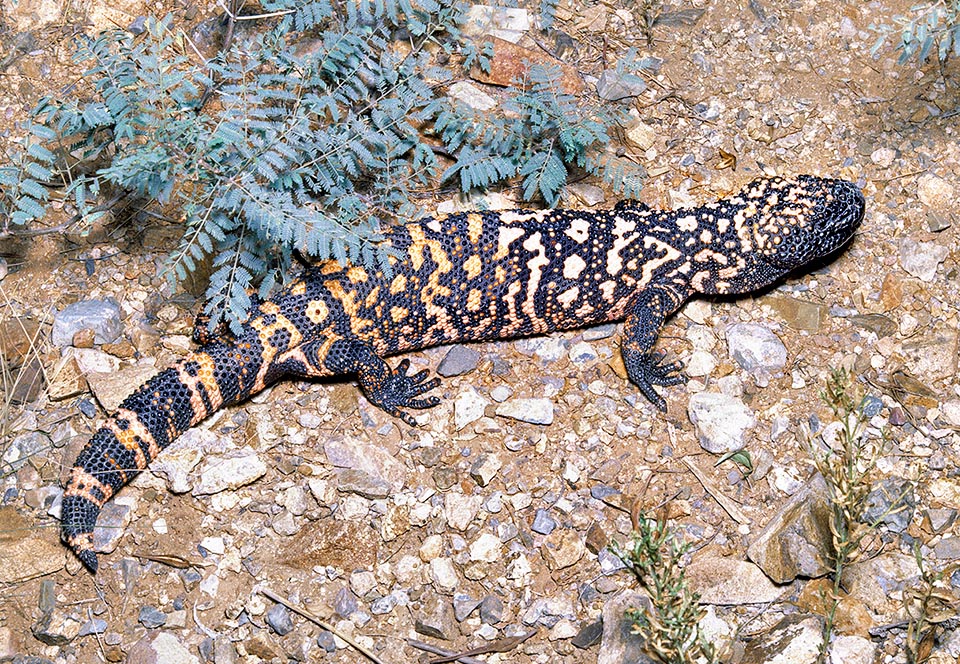
Heloderma suspectum may travel up to 1,5 km per day while looking for food. The front legs, robust with strong and sharp claws, allow him to dig and to climb trees while hunting nestlings. It attacks everything it encounters: small mammals, birds, reptiles and invertebrates, with a predilection for eggs, any size whatsoever. It is in turn preyed upon by birds of prey and coyotes, which it can hardly escape, and is today threatened by the loss of habitat and by the stupid capture for domestic terrariums © Giuseppe Mazza
For the coupling, the males exhibit their hemipenes, then put one back leg around the pelvis of the female and make their cloaca to match with the female’s one, in order to be able to introduce one of the hemipenes. The sperm flows along the hemipenis and goes in the oviducts to reach the eggs and fertilize them. The copulation lasts about two hours.
In 4-6 weeks after the fertilization, the egg is wrapped by the accessory coatings such as the albumen and the shell, not rigid, and finally is laid. The female lays the eggs usually in an underground shelter and for some days stays there to survey them. The incubation lasts for about 5 months. Between July and August, are laid 2 to 12 eggs (6 as an average). Since that usually the newborns get out from the nests between late April and early June, it is possible that the eggs open only in spring, or that they open in autumn and that the hatchlings remain in the nests until the next spring. This last hypothesis is sustained by the finding in Arizona, at the end of the month of October, during the excavation works for a building, of a nest of Gila containing 5 hatchlings that were getting out from the egg.
During the final phases of the development begins to start protruding from the upper jaw the “egg tooth” that will be utilized at the moment of the hatchling to break the shell. The newborns, that weigh about 30-35 grams and are about 15 cm long, are copies in miniature of the parents and are immediately active and endowed of venom.
Relations with the man
The Heloderma suspectum is often represented in the petroglyphs of the natives of the south-western regions of the present United States of America and in the painted pottery of the old Mexico.
These animals are rarely object of hunting by the native populations, seen that their skin, due to the presence of the osteoderms, cannot be utilized to produce artefacts and their flesh is traditionally, even if wrongly, often deemed to be poisonous. In reality, it seems that some populations like the Diegueño (or Kumeyaay), a tribe of natives living between southern California and Mexico ate them and used their own saliva to poison the arrows.
In the most recent years the Gila Monster as well as the Heloderma horridum are often kept in terraria as pets, despite their possible dangerousness and the high costs in the market. This phenomenon may represent a danger for the conservation of the species, whose wild population is rapidly decreasing due to the illegal hunting for commercial purposes as well as for the loss of the habitat.
→ To appreciate the biodiversity within the LIZARDS please click here.
